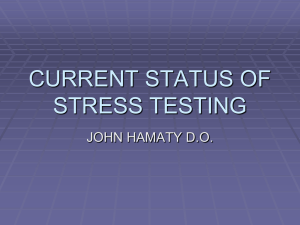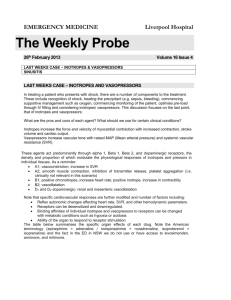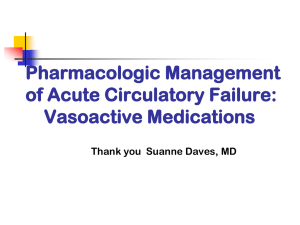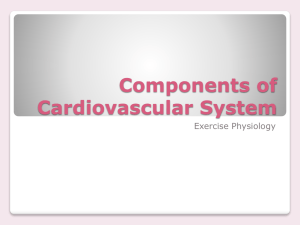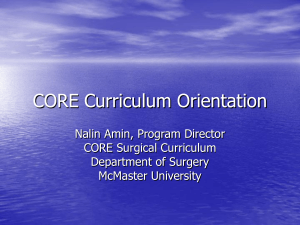Inotropes in cardiothoracic surgery
advertisement
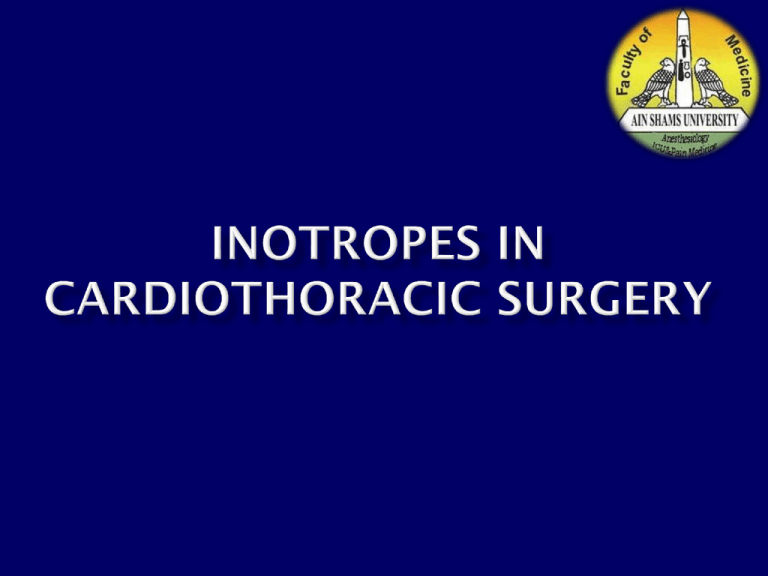
Introduction Classification of inotropes Postoperative myocardial dysfunction. Choice of inotrope Indications in specific settings Introduction An inotrope is an agent, which increases or decreases the force or energy of muscular contractions . Positive inotropic agent enhances myocardial contractility so; cardiac output, the amount of blood ejected by the heart with each beat, will also increase. Introduction (cont.) Maintenance of adequate oxygen balance is one of the primary objectives when dealing with patients undergoing cardiac surgery. Cardiac output is one of the major components of oxygen delivery . Introduction (cont.) Due to preoperative cardiac lesion and myocardial dysfunction secondary to the events related to cardiac surgery and cardio pulmonary bypass, circulatory support by pharmacological means is frequently required after surgery. Introduction(cont.) Adrenergic receptors αreceptors α1 β-receptors α2 β1 β2 Classification of inotropic agents cAMP dependent agents cAMP independent inotropic agents Other new agents adrenergic agonists Na+-K+-ATPase inhibitors: Calcium Sensitizers dopaminergic agonists: Potassium channels inhibitors vasopressin phosphodiesterase III isoenzyme inhibitors: Agonists of βadrenergic receptors natriuretic brain peptide Calcium Phenylephrine principal neurotransmitters in the sympathetic nervous system potent α- adrenoceptor agonist strong vasoconstrictor norepinephrine stimulates β1-adrenoceptors, increases both heart rate and contractility. Norepinephrine does not affect β2adrenoceptors. Dose : 2-20µg/min(0.04-0.4 µg/kg/min) Hormone secreted by the adrenal medulla Potent α- and β-adrenoceptor agonist. so a powerful vasoconstrictor, a positive inotrope, and a positive chronotrope. But, diastolic blood pressure may decrease as a result of vasodilation due to stimulation of β2adrenoceptor effects. Dose : 2-20µg/min(0.04-0.4 µg/kg/min) An endogenous catecholamine Stimulates both adrenergic and dopaminergic (D1 and D2) receptors. Low-dose infusion (<5 µg/kg/min) Intermediate doses (5-10 µg/kg/min) . Higher doses (>10 µg/kg/min) β 1-adrenergic agonist Had positive inotropic and peripheral vasodilative properties. As established dobutamine as a first line therapeutic choice in patients with decompensated HF. Dose : 2.5-10 µg/kg/min Inodilators postreceptor” mechanism of action oral administration . Milrinone. Dose : 50 µg/kg over 10 min , then 0.375-0.75 µg/kg/min ,max.: 1.13 mg/kg/min. It is one of calcium senstizers It act by increasing the sensitivity of contractile apparatus (especially troponine-T) to intracellular calcium. Proarrhythmic activity less common. Induce peripheral, pulmonary and coronary vasodilatation, via ATP-sensitive potassium channels Dose : is 6 to 12 µg/kg loading dose over 10 minutes followed by 0.05 to 0.2 µg/kg/min as a continuous infusion. Causes: aortic cross-clamping inadequate myocardial protection hypothermia with cardioplegia and topical iced solutions surgical trauma activation of the complement cascade by CPB reperfusion injury premature or excessive titration of inotropic agents Recovery pattern of cardiac function: postoperative changes in the systolic myocardial performance after heart surgery in patients undergoing cardiopulmonary bypass (CPB) Guided The expected need for inotropes clinical evidence of depressed myocardial function Empirical drug choice and titration, with careful hemodynamic monitoring Table 2. Predictive factors of inotropic support, as highlighted by several studies. Low ejection fraction (< 45%) History of congestive heart failure Cardiomegaly High LVEDP following ventriculogram MI within 30 days of operation* Older age (> 70 years) Longer duration of aortic cross-clamping Prolonged cardiopulmonary bypass* Urgent operation Re-operation* Female gender* Diabetes mellitus LVEDP = left ventricular end-diastolic pressure; MI = myocardial infarction. * statistical significance for coronary artery bypass surgery only. Choice of inotropes(cont.) Choice of inotropes(cont.) Enhance the diastolic function Choice of inotropes(cont.) Maintain the diastolic coronary perfusion pressure and thus an adequate myocardial blood flow. Choice of inotropes(cont.) It finally should have rapid titration times and onset of action and a short half-life Choice of inotropes(cont.) Catecholamines are the mainstay of current inotropic treatment they can be divided into more potent (epinephrine, isoproterenol, noradrenaline) and milder (dopamine, dopexamine, dobutamine Levosimendan PDE inhibitors Norepinephrine Dopamine Dobutamine Epinephrine Coronary artery bypass graft surgery: In most cases, no or only mild inotrope requirement. inotropes may be needed in case of preexisting ventricular dysfunction or in case of unsuccessful revascularization if the intra-aortic balloon pump alone is not enough. Indications in specific settings(cont.) emergency revascularization of acute myocardial infarction, dobutamine and PDE inhibitors. off-pump coronary artery bypass graft surgery (dopamine, dobutamine) Indications in specific settings(cont.) Chronic heart failure : Combination therapy (i.e. a PDE inhibitor administered along with a beta-adrenergic inotrope, dobutamine or epinephrine) may therefore be the treatment of choice in these patients Indications in specific settings(cont.) Diastolic dysfunction : No inotropes at all (or inotropes with a better effect on ventricular relaxation, such as PDE inhibitors, if systolic dysfunction coexists) Indications in specific settings(cont.) valvular surgery Moderately severe aortic stenosis, Inotropic support is rarely needed Indications in specific settings(cont.) Chronic aortic insufficiency Requiring adequate preload and inotropes Indications in specific settings(cont.) Mitral stenosis, chronic mitral regurgitation Treatment with inotropes is warranted. Indications in specific settings(cont.) Acute aortic and mitral regurgitation require aggressive inotropic support even preoperatively Indications in specific settings(cont.) Tricuspid regurgitation Inotropes are beneficial Indications in specific settings(cont.) Orthotopic cardiac transplantation: Routine inotropic support includes isoproterenol (to increase the automaticity, inotropism and pulmonary vasodilation) and dopamine (to add further support whilst maintaining the systemic perfusion pressures). Indications in specific settings(cont.) Right ventricular dysfunction: heart transplantation, lung transplantation pulmonary thromboendoarterectomy left ventricular assist device implantation, inadequate myocardial protection Successful management Right ventricular afterload pulmonary vasodilators The contractile strength inotropes : • dobutamine, •isoproterenol, • epinephrine, •PDE inhibitors maintenance of the aortic blood pressure vasoconstrictors Conclusion Postoperative myocardial dysfunction is a major concern in the setting of cardiac surgery since it is extremely frequent and is related to a greater morbidity and mortality. Inotropic drugs are nowadays an important therapeutic tools in the treatment of perioperative heart failure. Good selection usually guide our outcome.
